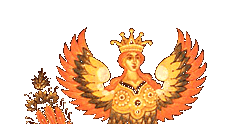 Nikolai Egorovich Sverchkov was born in 1817 in Tsarskoe Selo (Saint Petersburg) to the family of a horseman. An outstanding gift of subtley noticing peculiarities of horse breeds and their exterior appeared in the child's paintings at an early age. The father seeing his 9-year old son's talent in drawing sent him to an Art Academy, but in a year and a half Nikolai had to stop studying because of illness. The boy was receiving further education in public schools.
He gained knowledge and painting skills in painting by self-education, constantly drawing horses, and examining master's works. His father worked in the royal stables as a senior horseman, while helping to develop his son's talent. Nikolai was fond of horseback riding, going to horse races, and horse fairs.
In that he made acquaintance with other horse owners. Constantly watching horses in pastures, running, and racing gave him an unsurpassed database of information. The first portrait series of horses Sverchkov painted was in 1840 for the famous Saint Petersburg man S.A. Yakovlev. At the age of 22 (1839) he already had his first paintings at the Academy exhibition, for which he got the title "Free painter."
All the creative work Sverchkov did was devoted to painting horses. On the pictures and paintings he showed their usage in horse breeding, at races, hunting, and especially three horses with a carriage (the troika). Sverchkov's troikas ran through landscapes of Russia with deep snows with severe snowstorms. They ran through steppes and through woods, through dusty roads and snow fields, in the rain and snowstorms, at the dawn and sunset, in the foggy morning and frosty evening day and night. Nikolai Egorovich Sverchkov was born in 1817 in Tsarskoe Selo (Saint Petersburg) to the family of a horseman. An outstanding gift of subtley noticing peculiarities of horse breeds and their exterior appeared in the child's paintings at an early age. The father seeing his 9-year old son's talent in drawing sent him to an Art Academy, but in a year and a half Nikolai had to stop studying because of illness. The boy was receiving further education in public schools.
He gained knowledge and painting skills in painting by self-education, constantly drawing horses, and examining master's works. His father worked in the royal stables as a senior horseman, while helping to develop his son's talent. Nikolai was fond of horseback riding, going to horse races, and horse fairs.
In that he made acquaintance with other horse owners. Constantly watching horses in pastures, running, and racing gave him an unsurpassed database of information. The first portrait series of horses Sverchkov painted was in 1840 for the famous Saint Petersburg man S.A. Yakovlev. At the age of 22 (1839) he already had his first paintings at the Academy exhibition, for which he got the title "Free painter."
All the creative work Sverchkov did was devoted to painting horses. On the pictures and paintings he showed their usage in horse breeding, at races, hunting, and especially three horses with a carriage (the troika). Sverchkov's troikas ran through landscapes of Russia with deep snows with severe snowstorms. They ran through steppes and through woods, through dusty roads and snow fields, in the rain and snowstorms, at the dawn and sunset, in the foggy morning and frosty evening day and night.
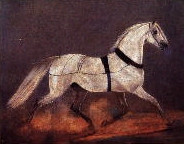 Let's take a look at several interesting pictures with the topic "Carriage with Three Horses." "Carriage with three horses at moony night," "Carriage with three horses in the steppe" (1850), "In snowstorm" (1855), "Three gray horses in the sledge" (1856), "Three horses in the snowstorm" (1896) (this picture is painted by the artist 2 years before his death).
In 1852 Sverchkov received the title "Academician of people's scene painting" for the picture "Carriage with three horses," for the painting "Road" in 1855 he received the title of Professor (A. S. Krasnikov, 1974). By the age of forty Sverchkov had received the highest appraisal of his paintings, recognition of his talent, and became the first among animal painters working in the XIX century to paint horse images of breeding kinds. In 1863 Sverchkov's paintings were presented at the World Exhibition and became decorations at the Louvre in Paris. For a beautiful painting with the image of race in Lamarshe Sverchkov was awarded with the Order of Honorable Legion. Then Sverchkov demonstrated his works at London's World Exhibition where 40 paintings were sold including 13 water-colored paintings. "Hunting on wolves" and "Horse Fair" received high appraisal, the last one was sold for 22,000 pounds. After incredible success in Paris and London Sverchkov, at the end of 1864, received an order to paint three painting with a historic theme. In 1866 he finished the first painting "Trip of Alexei Michailovich to see the troops," in 1874 he finished the painting "Tsar Alexei Michailovich with boyars at the falcon hunt," and finally "Trip of Tsar Ivan the Terrible to pray" appeared in 1878. These paintings are in the Chamber of Armor.
Portraits of riding horses present the big group of Sverchkov paintings. Sverchkov paintings "A. I. Panaeva in woman saddle on the horse" (1854) and "Russian officer on the black horse" (1854) are masterpieces of horse portraits featuring the lost Orlovo-Rostopchinskii breed. Among theme paintings which portray the tragedy and everyday life in horse breeding the best are: "The fire in steppe and running herd," "Arrival of A.A. Boldirev at the factory of T. T. Tula" (General A. A. Boldirev was vice-president of Tula trotter society), "Horse with a baby horse and killed wolf" (1892), "Horseman is taking the horse out of the stable" (1864), "Holstomer" (1891). Sverchkov, in 1891, painted Holstomer (a horse) against the background of a playing young herd of trotter females and babies. Horse breeder A.A. Stakhovich (1830-1913) found out and published in mass media that Holstomer and frisky trotter of Count A.G. Orlov, black sire Muzhik I of Hrenovski, born in 1803 are the same horse. Muzhik I wasn't black and piebald, it was black with big white spots on its forehead and all four legs. After Count A.G. Orlov's death (1737-1808) Muzhik I was castrated and sold. However he left black son Old Silky, born in 1812, who became the origin of all Orlov trotters of the private horse factory in Russia. Let's take a look at several interesting pictures with the topic "Carriage with Three Horses." "Carriage with three horses at moony night," "Carriage with three horses in the steppe" (1850), "In snowstorm" (1855), "Three gray horses in the sledge" (1856), "Three horses in the snowstorm" (1896) (this picture is painted by the artist 2 years before his death).
In 1852 Sverchkov received the title "Academician of people's scene painting" for the picture "Carriage with three horses," for the painting "Road" in 1855 he received the title of Professor (A. S. Krasnikov, 1974). By the age of forty Sverchkov had received the highest appraisal of his paintings, recognition of his talent, and became the first among animal painters working in the XIX century to paint horse images of breeding kinds. In 1863 Sverchkov's paintings were presented at the World Exhibition and became decorations at the Louvre in Paris. For a beautiful painting with the image of race in Lamarshe Sverchkov was awarded with the Order of Honorable Legion. Then Sverchkov demonstrated his works at London's World Exhibition where 40 paintings were sold including 13 water-colored paintings. "Hunting on wolves" and "Horse Fair" received high appraisal, the last one was sold for 22,000 pounds. After incredible success in Paris and London Sverchkov, at the end of 1864, received an order to paint three painting with a historic theme. In 1866 he finished the first painting "Trip of Alexei Michailovich to see the troops," in 1874 he finished the painting "Tsar Alexei Michailovich with boyars at the falcon hunt," and finally "Trip of Tsar Ivan the Terrible to pray" appeared in 1878. These paintings are in the Chamber of Armor.
Portraits of riding horses present the big group of Sverchkov paintings. Sverchkov paintings "A. I. Panaeva in woman saddle on the horse" (1854) and "Russian officer on the black horse" (1854) are masterpieces of horse portraits featuring the lost Orlovo-Rostopchinskii breed. Among theme paintings which portray the tragedy and everyday life in horse breeding the best are: "The fire in steppe and running herd," "Arrival of A.A. Boldirev at the factory of T. T. Tula" (General A. A. Boldirev was vice-president of Tula trotter society), "Horse with a baby horse and killed wolf" (1892), "Horseman is taking the horse out of the stable" (1864), "Holstomer" (1891). Sverchkov, in 1891, painted Holstomer (a horse) against the background of a playing young herd of trotter females and babies. Horse breeder A.A. Stakhovich (1830-1913) found out and published in mass media that Holstomer and frisky trotter of Count A.G. Orlov, black sire Muzhik I of Hrenovski, born in 1803 are the same horse. Muzhik I wasn't black and piebald, it was black with big white spots on its forehead and all four legs. After Count A.G. Orlov's death (1737-1808) Muzhik I was castrated and sold. However he left black son Old Silky, born in 1812, who became the origin of all Orlov trotters of the private horse factory in Russia.
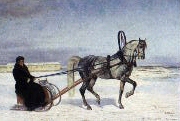 There are two water-colored paintings of Sverchkov, given as a gift in 1887 by the author to L.N. Tolstoi. "Holstomer in youth" and "Holstomer in old age." These water-colored paintings are kept in the L.N. Tolstoi museum in Moscow. With great warmth Sverchkov treats working peasants horses. The best paintings of this series are "Children riding," "A peasant on the gray horse," and "Red working horse." Many working horses were painted by N.E. Sverchkov like the paintings with a hunting theme "They are taking killed bear," "Borzatnik on the horse," "Hunter on bay piebald horse," etc. Exceptional interest in the creative heritage of the author is presented by portraits of Orlov trotters and theme paintings with the image of trotter horses. Great and sincere love is displayed by N. E. Sverchkov towards the Orlov trotter breed. There are two water-colored paintings of Sverchkov, given as a gift in 1887 by the author to L.N. Tolstoi. "Holstomer in youth" and "Holstomer in old age." These water-colored paintings are kept in the L.N. Tolstoi museum in Moscow. With great warmth Sverchkov treats working peasants horses. The best paintings of this series are "Children riding," "A peasant on the gray horse," and "Red working horse." Many working horses were painted by N.E. Sverchkov like the paintings with a hunting theme "They are taking killed bear," "Borzatnik on the horse," "Hunter on bay piebald horse," etc. Exceptional interest in the creative heritage of the author is presented by portraits of Orlov trotters and theme paintings with the image of trotter horses. Great and sincere love is displayed by N. E. Sverchkov towards the Orlov trotter breed.
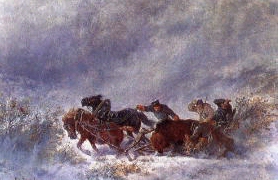 The first portraits of Orlov horses of Hrenovski where Sverchkov worked as horse painter are dated 1846. Portraits of Lebedia VI, gray, 1831; Vizapura III, 1839; Letuna, gray, 1838; Varvara I, black, 1844; Nepobedimogo II, gray, 1844 and several tens of other famous horses are a special treasure for the history of Orlov horse breeding. Portraits of famous female horse, light gray, Volna with a baby and Gornostai V are masterpieces by Sverchkov. Historian V.I. Koptev in "Essay of a Russian horse breeding" (1872) noticed: "N.E. Sverchkov painted many portraits of famous Hrenovski trotters which will stay forever in the eyes of future horse breeders as ideals and prototypes from which they should not separate. Without these precious images of trotters marked by N.E. Sverchkov's brush in paintings and then marked with a pencil in print, horse breeders would have a wide range of guesses about the exterior of horses and the imagination would draw a totally different image and not as they really were." The first portraits of Orlov horses of Hrenovski where Sverchkov worked as horse painter are dated 1846. Portraits of Lebedia VI, gray, 1831; Vizapura III, 1839; Letuna, gray, 1838; Varvara I, black, 1844; Nepobedimogo II, gray, 1844 and several tens of other famous horses are a special treasure for the history of Orlov horse breeding. Portraits of famous female horse, light gray, Volna with a baby and Gornostai V are masterpieces by Sverchkov. Historian V.I. Koptev in "Essay of a Russian horse breeding" (1872) noticed: "N.E. Sverchkov painted many portraits of famous Hrenovski trotters which will stay forever in the eyes of future horse breeders as ideals and prototypes from which they should not separate. Without these precious images of trotters marked by N.E. Sverchkov's brush in paintings and then marked with a pencil in print, horse breeders would have a wide range of guesses about the exterior of horses and the imagination would draw a totally different image and not as they really were."
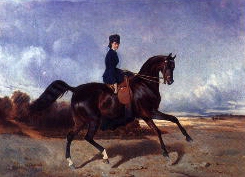 N.E. Sverchkov was painting only from real models and often traveled to paint the best horses by their owner's requests. V.I. Koptev in "Horse Breeding and Hunting Magazine" #2, 1864 told the story about Sverchkov's portraits of famous stallions in the V.I. Shishin stable (1780-1845): Seri Gornostai, 1829, and black Krolika, 1832. In 1844 a talented assistant of Count Orlov, creator of the Orlov trotter breed, Vasili Ivanovich Shishin divided his horses and sold them by lot to horse breeders V.P. Ohotnikov and N.I. Tulinov got stallions: Gornostai, Krolik, Bichok, Bulat. N.I. Tulinov convinced professor Sverchkov to come 2500 verst (1 verst = 1067 m) to paint portraits of famous ancestors of the Orlov kind including Krolik (descendent of Muzhik I) (Holstomer). In 1846 N.E. Sverchkov arrived at N.I. Tulinov manor in Martin village and painted four portraits: Gornostai, Krolik, Bulat, and Bogach, which decorated the master's den in his Moscow home. After the death of N.I. Tulinov in 1853 these four portraits went to V.I.Koptev. Later the portraits of Gornostai and Krolik were bought by I.I. Butovich to the Museum of Horse Breeding TSHA where they are now exhibited. N.E. Sverchkov was painting only from real models and often traveled to paint the best horses by their owner's requests. V.I. Koptev in "Horse Breeding and Hunting Magazine" #2, 1864 told the story about Sverchkov's portraits of famous stallions in the V.I. Shishin stable (1780-1845): Seri Gornostai, 1829, and black Krolika, 1832. In 1844 a talented assistant of Count Orlov, creator of the Orlov trotter breed, Vasili Ivanovich Shishin divided his horses and sold them by lot to horse breeders V.P. Ohotnikov and N.I. Tulinov got stallions: Gornostai, Krolik, Bichok, Bulat. N.I. Tulinov convinced professor Sverchkov to come 2500 verst (1 verst = 1067 m) to paint portraits of famous ancestors of the Orlov kind including Krolik (descendent of Muzhik I) (Holstomer). In 1846 N.E. Sverchkov arrived at N.I. Tulinov manor in Martin village and painted four portraits: Gornostai, Krolik, Bulat, and Bogach, which decorated the master's den in his Moscow home. After the death of N.I. Tulinov in 1853 these four portraits went to V.I.Koptev. Later the portraits of Gornostai and Krolik were bought by I.I. Butovich to the Museum of Horse Breeding TSHA where they are now exhibited.
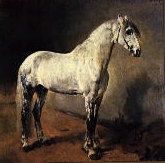 History did not save the portrait of ancestor's of gray Orlov trotter Bars I, born in 1784 in the Hrenov stable from Polkan I and a gray Holland female. In 1852 Sverchkov decided, to create an engraving "A.G. Orlov rides in a sledge with Bars I," taking as a model Dobrina gray, 1845, whose fancy exterior looked like the exterior of the ancestor. In 1851 Dobrina IV was taken from Hrenovski to the Moscow State stable, and in 1852 he was sold to N.A. Artiganieva, where Sverchkov in 1852 created the engraving of the ancestor Bars I. Then in 1853 the artist painted the portrait of Dobrina IV "Date in a field." In 1871 Sverchkov painted on the canvas a great painting "Count A.G.Orlov-Chesmenski in sledges with Bars I" based on the engraving Bars I .
In "Red trotter in running sledges with a rider" (1878) an unknown stallion is portrayed running on the winter road in the phase of not touching the ground. The artist had precisely painted the dynamic running that shows the high level of understanding of pace and balance of the right trotter movement. The painting of N.E. Sverchkov "Trotter female Krasa in droshky" (1870) which portrays fast running of a red horse on road in the steppe, and the dust raised from her hooves and wheels underlines the speed of her move. History did not save the portrait of ancestor's of gray Orlov trotter Bars I, born in 1784 in the Hrenov stable from Polkan I and a gray Holland female. In 1852 Sverchkov decided, to create an engraving "A.G. Orlov rides in a sledge with Bars I," taking as a model Dobrina gray, 1845, whose fancy exterior looked like the exterior of the ancestor. In 1851 Dobrina IV was taken from Hrenovski to the Moscow State stable, and in 1852 he was sold to N.A. Artiganieva, where Sverchkov in 1852 created the engraving of the ancestor Bars I. Then in 1853 the artist painted the portrait of Dobrina IV "Date in a field." In 1871 Sverchkov painted on the canvas a great painting "Count A.G.Orlov-Chesmenski in sledges with Bars I" based on the engraving Bars I .
In "Red trotter in running sledges with a rider" (1878) an unknown stallion is portrayed running on the winter road in the phase of not touching the ground. The artist had precisely painted the dynamic running that shows the high level of understanding of pace and balance of the right trotter movement. The painting of N.E. Sverchkov "Trotter female Krasa in droshky" (1870) which portrays fast running of a red horse on road in the steppe, and the dust raised from her hooves and wheels underlines the speed of her move.
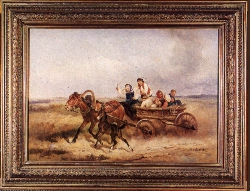 N.E. Sverchkov died at the age of 81 in 1898. He had created 350 paintings, 1000 drawings and 12 sculptures. The majority of these works except the sculptures are in the Museum of Horse Breeding TSHA. In realistic paintings of horse breeding portraits Sverchkov had many followers who tried to paint horses with high technical authenticity and reality. In 2001 the Orlov trotter breed was 225 years old, and differs from others with its exterior beauty, tall height, harness, type, and great adaptability to the tough climate conditions in Russia and the ability to run fast for long distances. In the beginning of XX century a well-known self-taught painter S.S. Voroshilov (1865-1911) as ordered by I.I.Butovich painted 33 horse portraits at the Prelepski stable. He painted the portraits from photos during autumn 1909 and summer 1910. Butovich appraised those portraits as the best of his works. The paining of S. S. Voroshilov "The herd of gray females of a Prilepski stud" received first prize at the Russian horse exhibition in Moscow in 1910. In the Museum of Horse breeding TSHA there are 40 paintings of S.S. Voroshilov, also there are 13 paintings of the painter V.V.Semenki, dated 1904-1916. On 12 paintings of Semenski, English pureblooded riding horses are portrayed and one painting portrays a trotter. It shows a gray Krepish (1904), several times winner of various verst races. The portrait of Krepish by Sevenski is made from a famous picture and is one of the best pictures with the image of Orlov trotter in the beginning of XX century. N.E. Sverchkov died at the age of 81 in 1898. He had created 350 paintings, 1000 drawings and 12 sculptures. The majority of these works except the sculptures are in the Museum of Horse Breeding TSHA. In realistic paintings of horse breeding portraits Sverchkov had many followers who tried to paint horses with high technical authenticity and reality. In 2001 the Orlov trotter breed was 225 years old, and differs from others with its exterior beauty, tall height, harness, type, and great adaptability to the tough climate conditions in Russia and the ability to run fast for long distances. In the beginning of XX century a well-known self-taught painter S.S. Voroshilov (1865-1911) as ordered by I.I.Butovich painted 33 horse portraits at the Prelepski stable. He painted the portraits from photos during autumn 1909 and summer 1910. Butovich appraised those portraits as the best of his works. The paining of S. S. Voroshilov "The herd of gray females of a Prilepski stud" received first prize at the Russian horse exhibition in Moscow in 1910. In the Museum of Horse breeding TSHA there are 40 paintings of S.S. Voroshilov, also there are 13 paintings of the painter V.V.Semenki, dated 1904-1916. On 12 paintings of Semenski, English pureblooded riding horses are portrayed and one painting portrays a trotter. It shows a gray Krepish (1904), several times winner of various verst races. The portrait of Krepish by Sevenski is made from a famous picture and is one of the best pictures with the image of Orlov trotter in the beginning of XX century.
|

